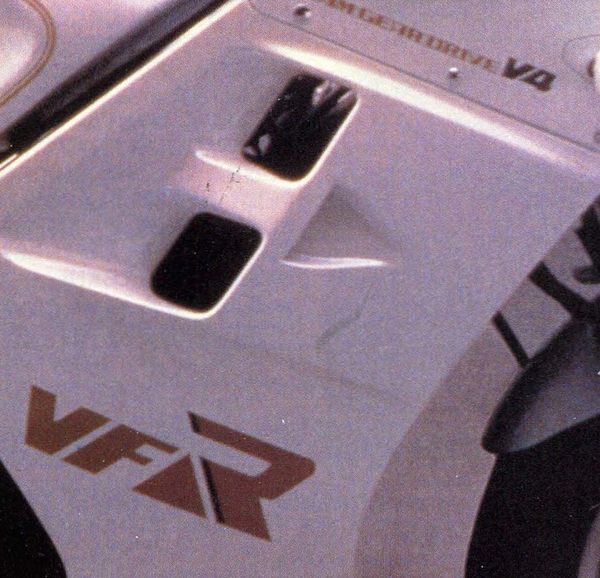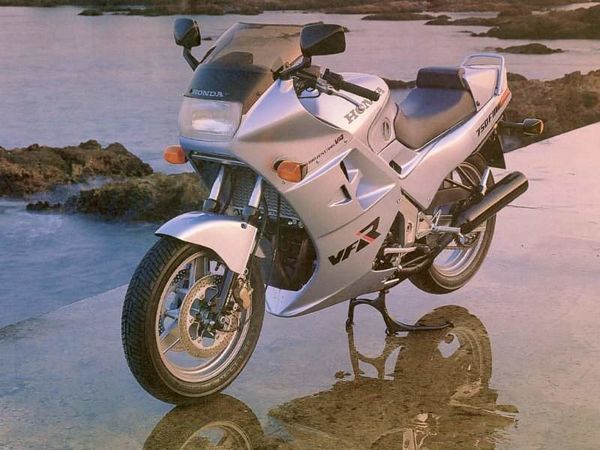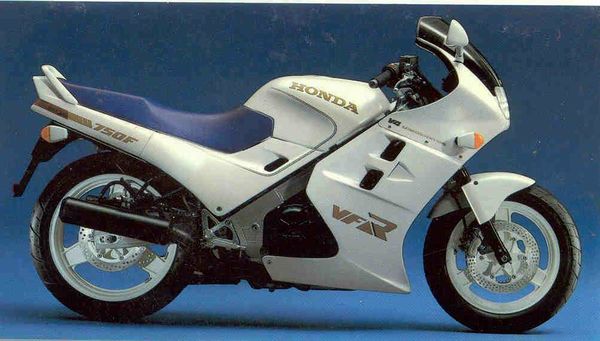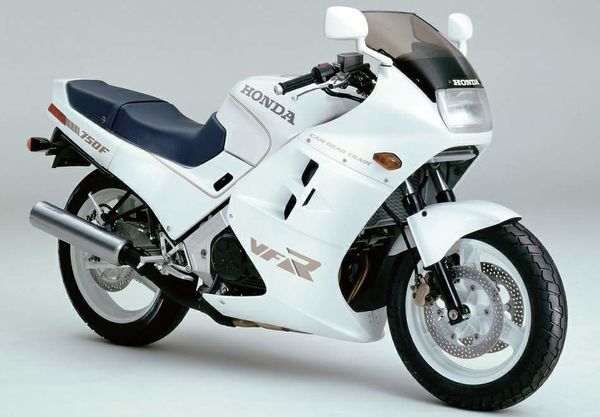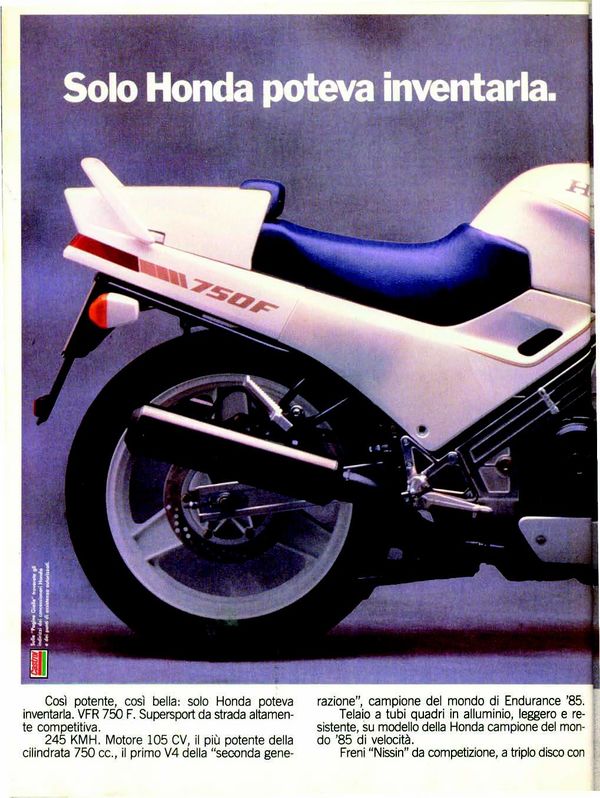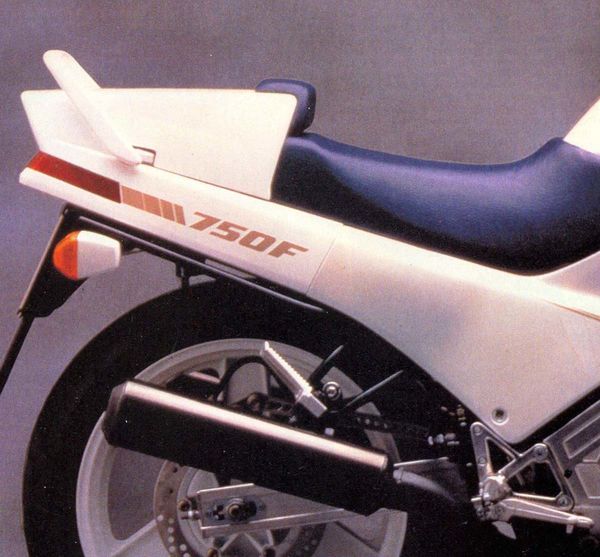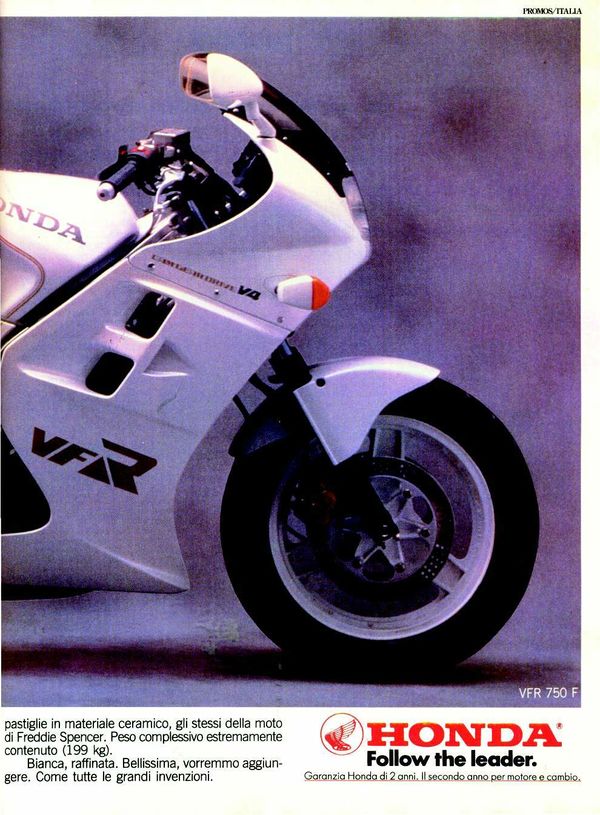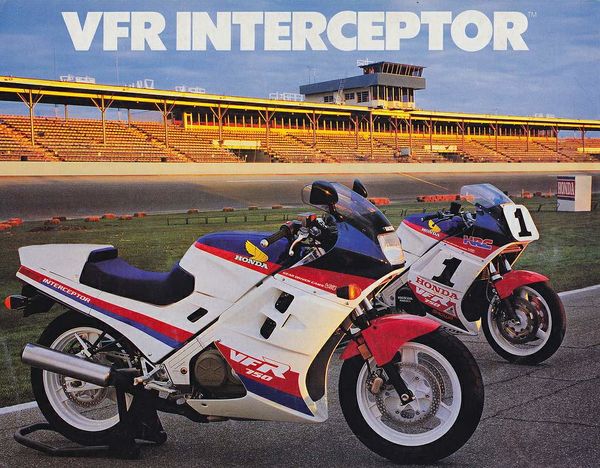Honda VFR 750F-G
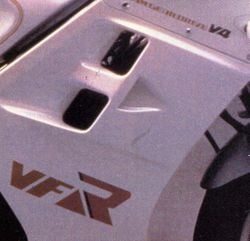 |
|
| Honda VFR 750F-G | |
| Manufacturer | |
|---|---|
| Production | 1986 |
| Class | Power Cruiser |
| Engine | Four stroke, 90°V-four cylinder, gear driven DOHC with rocker arm, 4 valve per cylinder |
| Compression ratio | 10.5:1 |
| Top Speed | 237 km/h / 147 mph |
| Ignition | Transistorized |
| Transmission | 6 Speed |
| Frame | Aluminum twin-spar frame |
| Suspension | Front: 37mm Showa air assisted telescopic fork with TRAC Anti-Dive Rear: Pro-Link adjustable for preload only with remote adjuster |
| Brakes | Front: 2x 276mm discs, 2 piston calipers Rear: Single 256mm disc 2 piston caliper |
| Front Tire | 110/90 V16 |
| Rear Tire | 130/80 V18 |
| Wheelbase | 1475 mm / 58.1 in |
| Weight | 198 kg / 347 lbs (dry), 222 kg / 489.4 lbs (wet) |
| Recommended Oil | Honda GN4 10W-40 |
| Fuel Capacity | 20 Liters / 5.3 US gal |
| Manuals | Service Manual |
It could reach a top speed of 237 km/h / 147 mph.
Engine[edit | edit source]
The engine was a Liquid cooled cooled Four stroke, 90°V-four cylinder, gear driven DOHC with rocker arm, 4 valve per cylinder. The engine featured a 10.5:1 compression ratio.
Drive[edit | edit source]
Power was moderated via the Wet multiplate.
Chassis[edit | edit source]
It came with a 110/90 V16 front tire and a 130/80 V18 rear tire. Stopping was achieved via 2x 276mm discs, 2 piston calipers in the front and a Single 256mm disc 2 piston caliper in the rear. The front suspension was a 37mm Showa air assisted telescopic fork with TRAC Anti-Dive while the rear was equipped with a Pro-Link adjustable for preload only with remote adjuster. The VFR 750F-G was fitted with a 20 Liters / 5.3 US gal fuel tank. The bike weighed just 198 kg / 347 lbs. The wheelbase was 1475 mm / 58.1 in long.
Photos[edit | edit source]
Overview[edit | edit source]
Honda VFR 750F-G
HONDA VFR INTERCEPTOR HISTORY
Written by: Robyn Landers rblanders@math.uwaterloo.ca Last revised: September 1995 (version 1.1) Revisions: mention blue VFR700F2; add a couple spec. details Copyright: may be freely copied as long as you include this header.
INTRODUCTION
In this article, I describe the Honda VFR Interceptor in its various incarnations from 1986 to 1987. The terminology I adhere to for the Honda V4 bikes is as follows: 1st generation V4: Sabre and Magna, 1982-1985 (Magna continued) 2nd generation V4 (1st generation Interceptor): VF, 1983-1985 3rd generation V4 (2nd generation Interceptor): VFR, 1986-1987 4th generation V4 (1st generation VFR, no longer "Interceptor"): 1990-present
This terminology follows major engine designs, not styling or chassis designs. It leaves out certain models, notably the VF1000R Interceptor (not to be confused with the VF1000 Interceptor), which was kind of a transition between 2nd and 3rd generation V4s, and also the ST1100 whose engine is a V4 but doesn't fit the pattern established by the original V4 layout. It also ignores the ongoing Magna model, but perhaps we can agree that the Magna has seen less significant development focus than the VFR concept, and has followed along with the VFR. Finally, it ignores the race-oriented RC30 and RC45.
SOURCES
My sources of information are mainly Cycle World, February 1986, Cycle Canada, July 1986; and Motorcyclist, November 1986, Also some Honda brochures, etc.
OVERVIEW
In 1986, Honda introduced a totally redesigned VF Interceptor, giving it the new name VFR Interceptor. The only thing carried over from the original was the 90 degree V4 concept with identical bore and stroke. Everything else was new. (Okay, maybe except for the turnsignals)
The history of this model is complicated by the fact that the USA had imposed a stiff tariff on bikes over 700cc in order to protect Harley Davidson. This gave rise to a greater discrepancy in the availability of different models for different markets than was usually the case.
I don't have any information about the European market, but I can summarize the Canadian and American VFR picture. It is simplest in Canada. We got a 750cc VFR Interceptor for 1986, and that is all. It was discontinued in 1987 as Honda trimmed its line down to a paltry 6 or 7 street bikes, after a high of about 50 in 1980 or 1981. The VFR Interceptor lasted just this one year, yielding to the Hurricanes in 1987. It was not seen again until its reappearance in 1990 redesigned again and renamed simply VFR. The Canadian VFR Interceptor was white with red and blue trim, and featured separate round instruments. Other characteristics will become apparent later. (Canada also got the RC-30, but that's another story.)
In the USA, the picture is more complicated. There were three models, and they lasted for two years. First, there was a 750cc model essentially the same in appearance and specification (except for the usual Canada vs USA differences) to the Canadian model. Next, there was also a destroked 700cc tariff-beater, called the VFR700 Interceptor. Both these models were white with red and blue trim, and round gauges. Thirdly, and most interestingly, was the VFR700F2. This bike was all white, with understated gold pinstriping, and an automotive-style instrument panel which was essentially what you see now on the 90-93 VFR. In fact, this model bears many visual similarities to the 90-93 models. This F2 model was also available in dark blue and silver metallic, with silver wheels. All I can tell you about the European version(s) is that they had a white 750cc model. This is not the whole story. By the way, while Canada lost the Interceptor after 1986, and both the USA and Canada lost the Sabre after 1985, the Magna persisted. It was significantly overhauled in 1987 when it gained a 4 pipe exhaust, solid disc rear wheel, Testarossa inspired side covers, and many other styling changes in addition to inheriting some engine improvements from the VFR lineage. However, it did not get the gear driven cams (and accompanying cure for the cam problem) until later. COMMON REDESIGN FEATURESAll the versions of the new VFR Interceptor share these major new features compared to the VF Interceptor: Engine, intake, exhaust:- 180 degree crank instead of 360, new firing order- one rocker arm per cam lobe instead of a forked rocker per pair, and individual oiling jets per cam lobe- new valve timing, optimized for peak power at 10,500- gear driven cams that ride in ball bearings- lighter pistons, rings, valves, con-rods, cranks, cams- repositioned 34mm carbs, bigger airbox, new exhaust system
Frame, running gear:- aluminum frame- wheelbase 15mm shorter, rake steepened to 27.8 degrees, trail increased from 96mm to 108mm- forks decreased to 37mm, no longer braced- no front or rear rebound damping adjustability, unlike VF- revised TRAC anti-dive system, new brakes, 3 spoke white alloy wheels- approximately 50 pound weight reduction The redesigned valve train and oiling system cured once and for all the cam problem that plagued the original VF. VFR 750 F INTERCEPTORHere are the Canadian model specs of interest: List price $6799 (Cdn)Engine: 748cc, 70 x 48.6mm bore x stroke, compression ratio 10.5:1 carburetion: four Keihin 34mm CV Chassis: wheelbase 1480mm rake/trail 27.6 degrees/108 mm suspension travel 140 mm front, 110 mm rear air assisted fork with TRAC anti-dive tires 110/90V16 front, 130/80V18 rear wet weight (observed) 505 lb with
full tank dry weight (claimed) 436.5 lb Performance:(claimed) horsepower 104 claimed (at the crank) torque 76.5 N-m (56.4 lb-ft) @ 8500 RPM claimed fuel capacity 20L including 4L reserve(observed) fuel consumption 6.6L/100km (42.7 mpg imperial) quarter mile 11.32 seconds at 122.11 mph; top speed 149 mph. measured rear-wheel horsepower 87 hp at 11,000 rpm torque peak at 8500 rpm.
Comparisons against other 1986 Canadian sport models: Suzuki GSX-R: 86 HP at 10,500, torque peak at 8000 rpm, lower power than VFR below 5500 rpm, and more than VFR until about 10,500. Yamaha FZ: 87 HP at 10,500, torque peak at 7500. More power than VFR or GSX-R everywhere up until almost 11,000.
I have only a few American specs for the 750cc model: claimed horsepower 104, quarter mile 11.05 sec at 124.4 mph,
200 yard top-gear roll-on from 50 mph results in 76.7 mph terminal speed.
VFR 700 F2 INTERCEPTORThese are American model specifications:
List price $4498 USEngine:
699cc, 70 x 45.4 bore x stroke, compression ratio 10.5:1
carburetion four Keihin CV 34/31 mmChassis:
wheelbase 1480 mm
rake/trail 27.8 degrees/4.3 inches (108 mm)
front suspension 37mm Showa fork, 5.5 in travel, adjustments for air pressure and TRAC anti dive
rear suspension Pro-Link, Showa damper, 4.1 in travel, preload adjustment tires 110/90V16 front, 130/80V18 rear weight 501 lb wet, 470 lb dry tank
Performance:
(claimed)
horsepower 92 claimed, torque not listed(observed)
fuel consumption 40 to 45 mpg American
average 200 yard top gear acceleration from 50 mph results in 73.4 mph terminal speed
best 1/4 mile 12.08 sec at 110.3 mph
projected best 1/4 mile 11.7 at 114.8.The 750 listed for $5298 US while both the 700 and the 700F2 listed for $4498 US. Mechanically they're nearly identical aside from the stroke reduction. Compression ratio, combustion chamber shape, carburetion stayed the same.
Performance comparison to other bikes:Honda Nighthawk S quarter mile 12.46 sec at 106.2 mph; top gear 50mph;roll on results in 69.5 mph at 200 yards. So, the 700F2 falls right in between the 750F and the Nighthawk S.
Critical chassis parts in all 700/750 Interceptors are identical. The F2 has an automotive style dashboard (likethe '90-93 VFRs) while the others have usual round gauges. No fuel gauge, but there is a warning light.
All F2 testers wanted firmer springs and less compression damping front and back, and some wanted more rebound damping.
| Make Model | Honda VFR 750F-G |
|---|---|
| Year | 1986 |
| Engine Type | Four stroke, 90°V-four cylinder, gear driven DOHC with rocker arm, 4 valve per cylinder |
| Displacement | 748 cc / 45.6 cub in |
| Bore X Stroke | 70 x 48.6 mm |
| Compression | 10.5:1 |
| Cooling System | Liquid cooled |
| Induction | 4x 34.5mm Keihin VD carburetors |
| Lubrication | Forced pressure and wet sump |
| Ignition | Transistorized |
| Starting | Electric |
| Max Power | 77.4 kW / 106 hp @ 10500 rpm |
| Max Torque | 66 Nm / 6.7kgf-m / 48.7 ft-lb @ 7500 rpm |
| Clutch | Wet multiplate |
| Transmission | 6 Speed |
| Final Drive | Chain |
| Primary Reduction | 1.9393 (63/33) |
| Final Reduction | 2.8125 (45/16) |
| Gear Ratios | 1st 2.8461 (37/13) 2nd 2.0625 (33/16) 3rd 1.6315 (31/19) 4th 1.3333 (28/21) 5th 1.1538 (30/26) 6th 1.0357 (29/28) |
| Frame | Aluminum twin-spar frame |
| Front Suspension | 37mm Showa air assisted telescopic fork with TRAC Anti-Dive |
| Front Wheel Travel | 140 mm / 5.5 in |
| Rear Suspension | Pro-Link adjustable for preload only with remote adjuster |
| Rear Wheel Travel | 105 mm / 4.1 in |
| Front Brakes | 2x 276mm discs, 2 piston calipers |
| Rear Brakes | Single 256mm disc 2 piston caliper |
| Front Tire | 110/90 V16 |
| Rear Tire | 130/80 V18 |
| Rake | 27.5 ° |
| Trail | 108 mm / 4.2 in |
| Wheelbase | 1475 mm / 58.1 in |
| Dry Weight | 198 kg / 347 lbs |
| Wet Weight | 222 kg / 489.4 lbs |
| Fuel Capacity | 20 Liters / 5.3 US gal |
| Consumption Average | 5.3 L/100 km / 18.6 km/l / 44 US mpg |
| Standing ¼ Mile | 11.6 sec / 192 km/h / 119 mph |
| Top Speed | 237 km/h / 147 mph |
